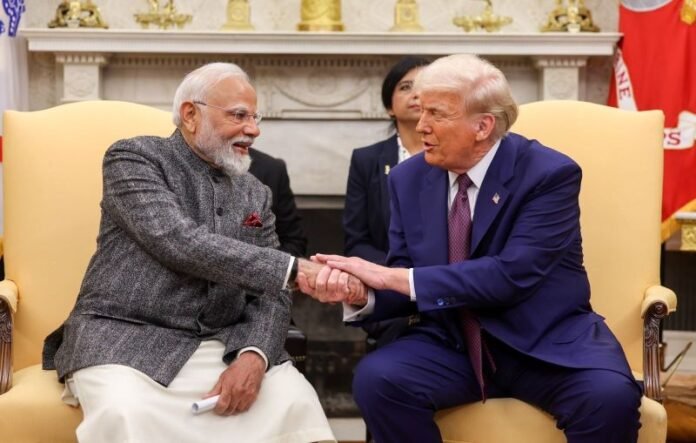Saptrishi Soni: Saptrishi Soni: In a dramatic escalation of trade tensions, U.S. President Donald Trump, via Truth Social, has termed both India and Russia as “dead economies,” while rolling out sweeping protectionist measures that significantly raise the stakes in global geopolitics and economics.
Trump’s Provocative Outburst and Tariff Shock
Trump’s remarks came a day after he announced a 25% tariff on all imports from India—effective August 1—alongside unspecified penalties linked to India’s purchases of Russian oil and arms. Branding Indian tariff regimes as “among the highest in the world,” he declared:
“I don’t care what India does with Russia. They can take their dead economies down together, for all I care. We have done very little business with India…”
He further warned Dmitry Medvedev—Russia’s former president—to “watch his words” amid rising geopolitical tension.
Trump framed these moves within a broader doctrine of “reciprocal tariffs,” reflecting his administration’s aggressive push to counter perceived trade abuses worldwide. Economic Fallout and Sectoral Impact
Experts warn India’s export sectors—particularly electronics, pharmaceuticals, textiles, and jewelry—face serious disruption under the new tariff regime. Analysts estimate that nearly 10% of Indian exports to the U.S. could be hit, including projects worth $11 billion in pharmaceuticals and automotive goods. Indian sources project that reciprocal tariffs could affect up to 87% of exports to the U.S., with losses estimated around $7 billion annually.
Strategic Realignment: U.S.–Pakistan Oil Deal
Adding to India’s diplomatic woes, Trump announced a strategic partnership with Pakistan to jointly develop its touted “massive oil reserves,” hinting that Pakistan might someday export oil to India. However, independent data indicates Pakistan’s proven oil reserves are limited—between 234 and 353 million barrels—providing less than two years of domestic consumption without imports. Production remains at approximately 88,000 barrels per day, covering only 15% of need.
Political Signaling and Trump’s Aggressive Will
Trump’s rhetoric reflects assertive use of economic coercion to force alignment with U.S. interests, especially on defense, energy, and trade policies. Analysts view these aggressive moves as pressure tactics aimed at reshaping India’s strategic choices—particularly its defense and oil ties with Moscow.
Seeking to bind India closer, Trump previously worked trade deals with favorably aligned countries like South Korea and the EU, signaling rejection of an independent Indian posture in global affairs.
Indian Government Response and Strategic Resistance
India’s Ministry of Commerce and Industry said it has “taken note” of the tariffs and continues pursuing a “fair, balanced and mutually beneficial bilateral trade agreement” . Despite Trump’s claims, India had already initiated trade talks, expecting a more cooperative outcome.
External Affairs Minister S. Jaishankar reaffirmed India’s sovereign right to engage in defense and energy cooperation, underlining that New Delhi will not accept moral lecturing from the West.
Why India Seems a “Dead Economy” to Trump
Trump’s dismissal stems from stark trade imbalances and India’s policy environment: he labels India as having “some of the highest tariffs and non‑monetary trade barriers” globally—culminating in minimal U.S.-India trade engagement.
Despite being the fourth-largest economy, India’s export volume to the U.S. remains modest. Meanwhile, India’s reliance on Russian energy and defense equipment, especially for over 65% of its arms imports in the past two decades, has drawn Trump’s ire.
Analysis: Costs and Consequences for India
The 25% tariff and potential secondary sanctions threaten to derail India’s strategic goal to double bilateral trade to $500 billion by 2030. Economists warn this wave of protectionism could spark inflation, weaken export competitiveness, and weaken India’s standing against rivals like Vietnam and Bangladesh.
Trump’s embrace of Pakistan signals a strategic balancing act: by aligning more closely with Islamabad on energy and trade, Washington may be marginalizing India, signaling preference. This risks deepening India’s geopolitical vulnerability, particularly given tense India–Pakistan ties following events like the Pahalgam terror attack.
For now, India remains firm. New Delhi insists on maintaining an independent foreign policy while negotiating trade terms it deems fair. As trade talks continue, the government must prepare to mitigate economic shockwave and preserve core strategic interests.




